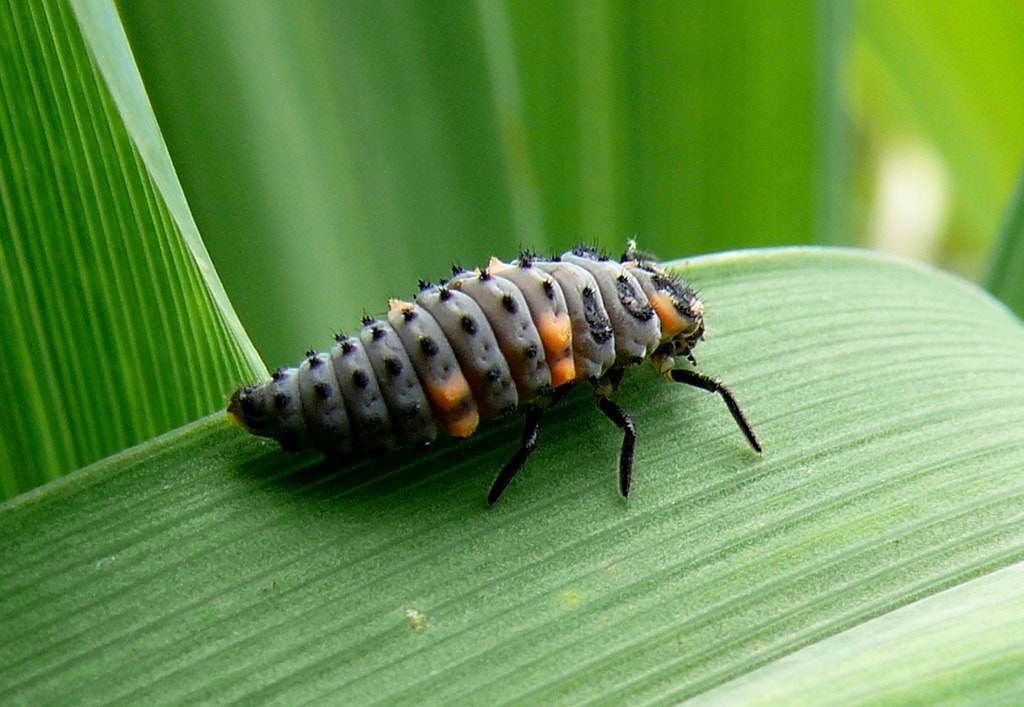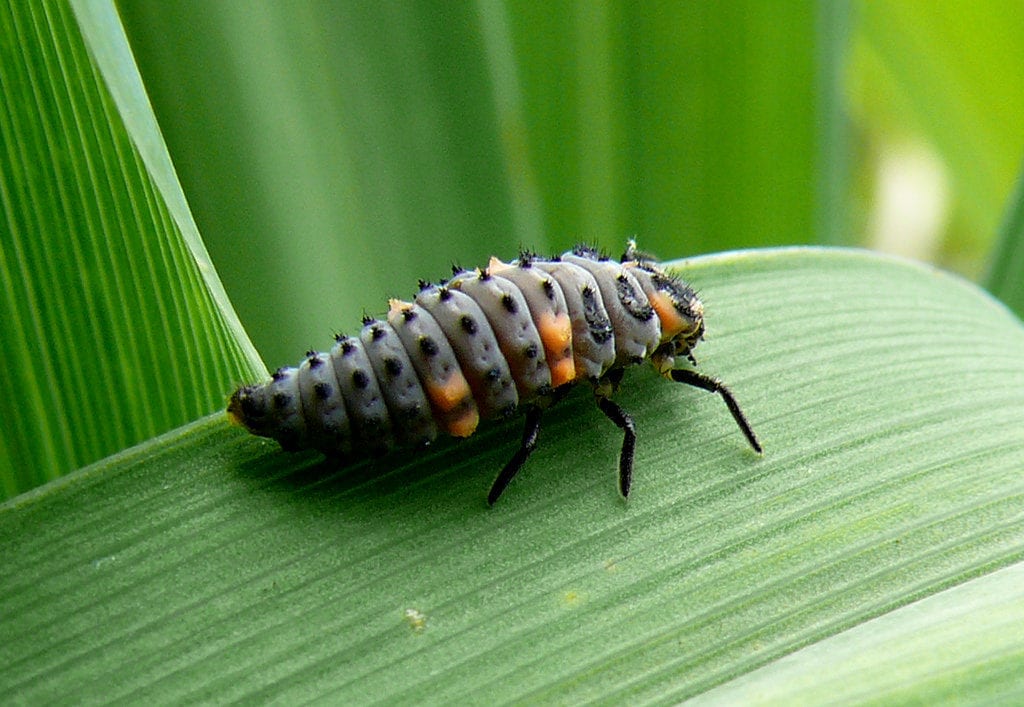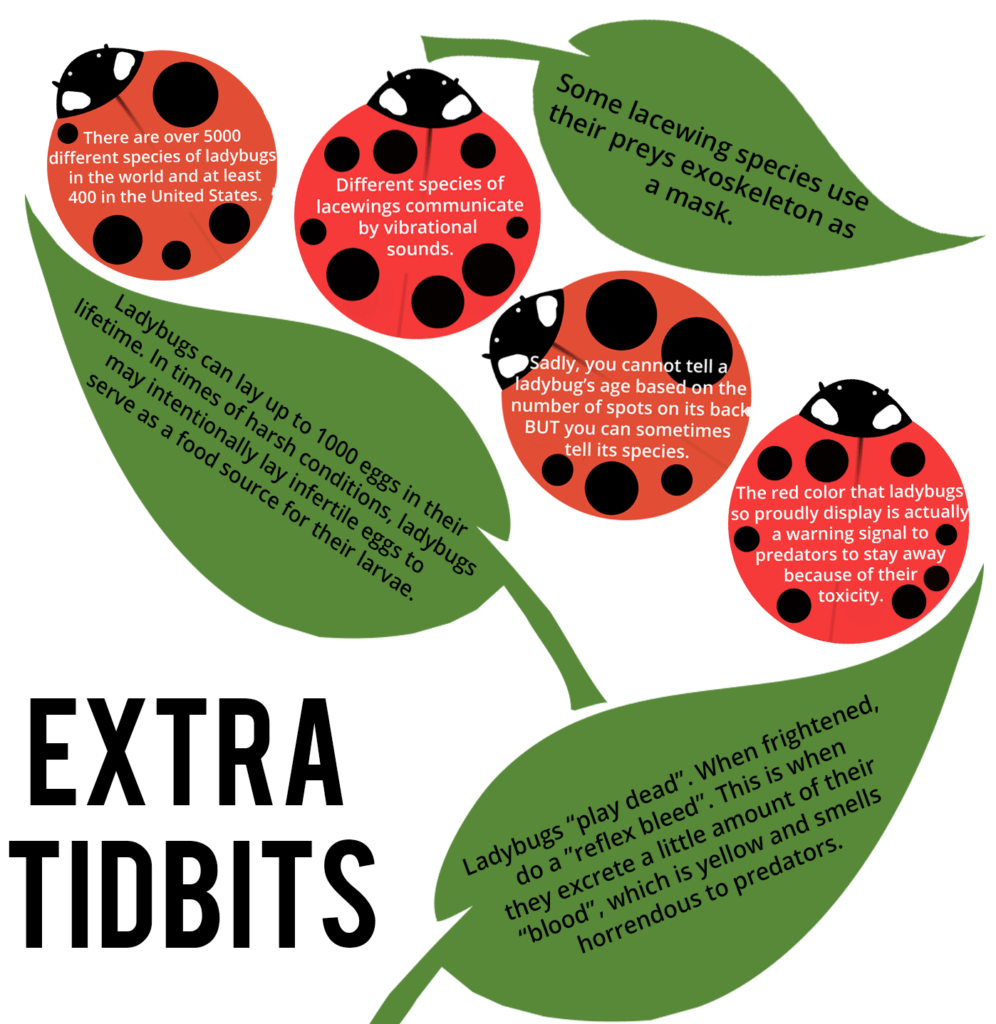Bee-Wise About Pesticides

Written by Emily Wang, ECOLIFE Intern
The oh-so-adorable ladybug is more than just the colorful spotted critter whizzing by. Amazingly, insects like the ladybug are used as natural pesticides to eliminate commonly unwanted pests such as aphids and caterpillars who ravage through our leafy greens. This method of controlling pests using other living organisms is referred to as biological control or biocontrol. The benefit of biocontrol is that it utilizes existing predator-prey relationships. This means risks associated with using chemical insecticides are eliminated, keeping you and your aquaponics system safe and healthy.
The red and black adult form that we are familiar with can reportedly consume about 50 aphids per day. Additionally, the ladybug’s voracious larvae can eat their weight in aphids each day and further rid your produce of these pests. Therefore, it is of utmost importance that we acquaint ourselves with the appearance of these beneficial ladybug babies; otherwise, we might try to exterminate these spiky creepy critters. Typically, ladybug larvae are black with the occasional orange markers and resemble the crocodile equivalent of an insect, but do not let its unattractive appearance dictate its fate!
Although ladybugs are famous for gobbling up aphids, their tastes extend to whiteflies, scale insects such as the cochineal, and mealybugs because they are unarmored and make for an easy and tasty meal. Additionally, ladybugs will eat mites, which to our eyes are nearly invisible, but for a ladybug will make a wonderful midday snack. Luckily, all these foods that these little guys love to feast on are common pests on our beloved plants. That’s mutualism for ya!
The following tips are provided to ensure that your little ladies don’t fly away prematurely!
- When they arrive, the ladybugs must be released in the evening into a soaking wet garden that has some aphid or pest problems. This can be achieved by wetting everything down for about 3-5 minutes at dusk.
- Ladybugs will not fly in the dark and are less active in cooler temperatures. By releasing them just after sunset, this will invite them to stay the night.
- A soaking wet garden welcomes ladybugs and will provide opportunities for them to quench their thirst.
- If ladybugs encounter food as they’re drinking and wandering about, they will likely make your garden their new home.
- Be nice to those spiky looking babies and don’t destroy eggs, which are yellowish-orange ovals laid on the undersides of plant leaves.
Instead of purchasing ladybugs, you can also try attracting local ladybugs and other beneficial insects using three easy steps.
- Don’t use chemicals of any kind in your garden!
- Provide enough water by spraying your plants down.
- Grow plants whose small flowers produce pollen and nectar that the adults can easily get to for a sweet treat. We recommend Queen Anne’s Lace, butterfly weed, tansy, and goldenrod. Other sources have also recommended herbs such as dill, fennel, and caraway.
 For those in hot and dry climates (above 85°F), the Green Lacewing may be a more suitable alternative to ladybugs. The delicate lacewing is another beneficial insect that is a natural predator to many pests on your darling plants. Although the adults feed on aphids and whiteflies, their diet extends to nectar, pollen, and aphid honeydew. Similar to ladybug larvae, the lacewing larvae are also active predators, so much so that they are nicknamed the “Aphid Lion”. Therefore, it is important to provide food for the adults so they will stay and lay their eggs.
For those in hot and dry climates (above 85°F), the Green Lacewing may be a more suitable alternative to ladybugs. The delicate lacewing is another beneficial insect that is a natural predator to many pests on your darling plants. Although the adults feed on aphids and whiteflies, their diet extends to nectar, pollen, and aphid honeydew. Similar to ladybug larvae, the lacewing larvae are also active predators, so much so that they are nicknamed the “Aphid Lion”. Therefore, it is important to provide food for the adults so they will stay and lay their eggs.
Perhaps not the most adorable beings, the larvae of lacewings are pale with dark markings and similar in appearance to an alligator with pincers. The larvae utilize its pincers by vigorously attacking its prey, injecting a paralyzing venom, and drawing out the body fluids of its helpless victim. The avid lacewing larvae are predators of the eggs and immature stages of many soft bodied insects including: aphids, spider mites, caterpillar eggs, thrips, whiteflies, leafhoppers, some beetle larvae, scales, eggs of pest moths, and mealybugs. These bold baby lacewings attack the eggs of most pests and if the bodies are not too hard or fast moving, will attack the adult pest stage as well.
Because of their large appetite, these larvae are useful for quick cleanups. These little ones are a wonderful and cost effective addition to any pest control program and work in concert with most beneficial insects. Use approximately 10 lacewing eggs/larvae per plant. It has been reported that a good predator-prey ratio for effective control is between 1:3 to 1:5.
The best time to release lacewings is early morning or later afternoon, but never release in the heat of the day. For best results, release should be to an area with pest-affected plants. However, when release is inconvenient, these beneficial bugs can be stored in the refrigerator for up to 48 hours. Warmer temperatures will speed up their emergence and newly hatched lacewing larvae are hungry and will cannibalize each other if they are not released quickly.
What’s your natural pest control secret? Comment below to share! 
Classroom Corner!
Eleven across is… aquaponics? Share the value of utilizing biocontrol and natural products with your students with this fun crossword puzzle!
Learn how to ban unwanted pests in a way that doesn’t hurt our environment!